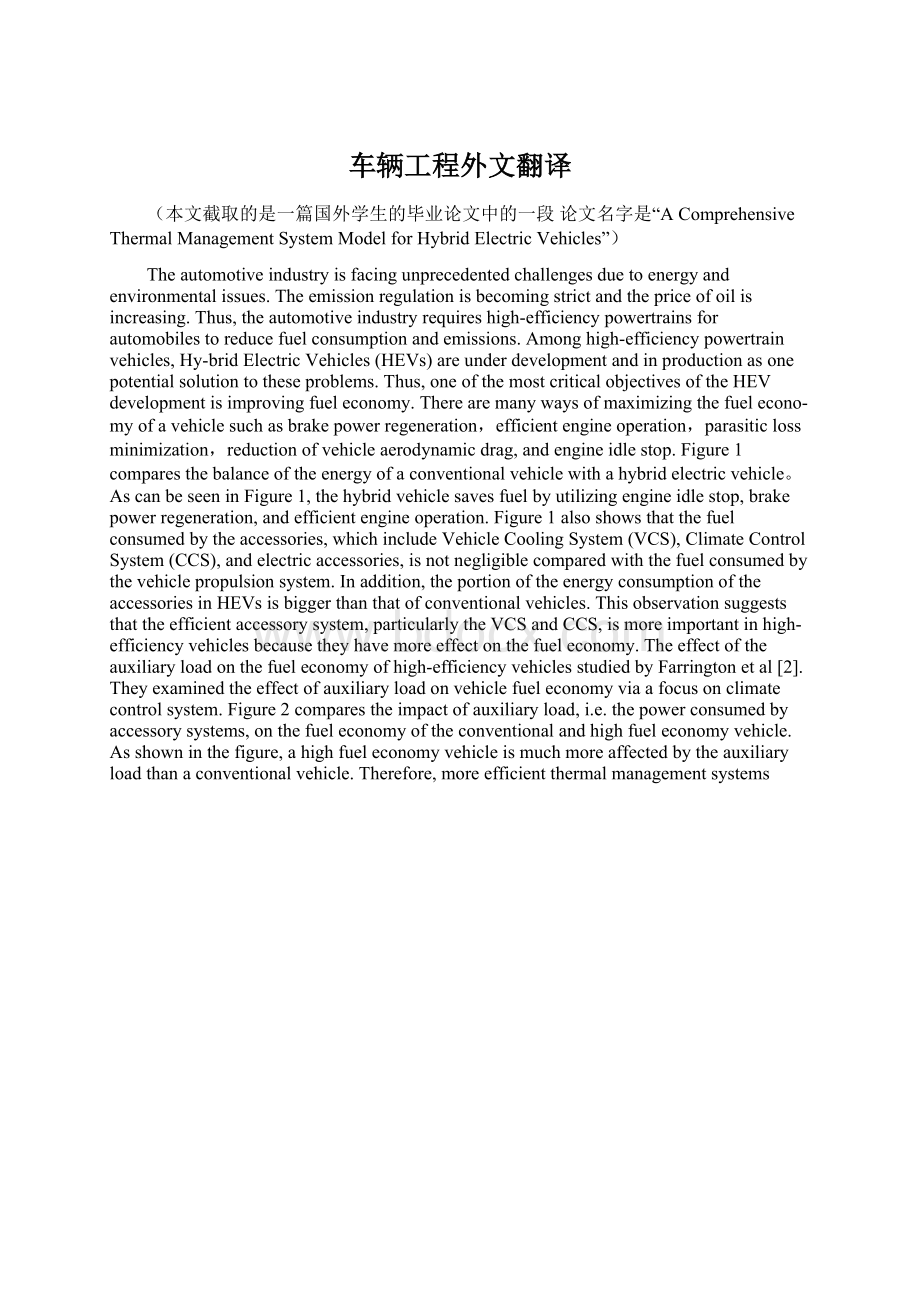车辆工程外文翻译.docx
《车辆工程外文翻译.docx》由会员分享,可在线阅读,更多相关《车辆工程外文翻译.docx(9页珍藏版)》请在冰豆网上搜索。

车辆工程外文翻译
(本文截取的是一篇国外学生的毕业论文中的一段论文名字是“AComprehensiveThermalManagementSystemModelforHybridElectricVehicles”)
Theautomotiveindustryisfacingunprecedentedchallengesduetoenergyandenvironmentalissues.Theemissionregulationisbecomingstrictandthepriceofoilisincreasing.Thus,theautomotiveindustryrequireshigh-efficiencypowertrainsforautomobilestoreducefuelconsumptionandemissions.Amonghigh-efficiencypowertrainvehicles,Hy-bridElectricVehicles(HEVs)areunderdevelopmentandinproductionasonepotentialsolutiontotheseproblems.Thus,oneofthemostcriticalobjectivesoftheHEVdevelopmentisimprovingfueleconomy.Therearemanywaysofmaximizingthefuelecono-myofavehiclesuchasbrakepowerregeneration,efficientengineoperation,parasiticlossminimization,reductionofvehicleaerodynamicdrag,andengineidlestop.Figure1comparesthebalanceoftheenergyofaconventionalvehiclewithahybridelectricvehicle。
AscanbeseeninFigure1,thehybridvehiclesavesfuelbyutilizingengineidlestop,brakepowerregeneration,andefficientengineoperation.Figure1alsoshowsthatthefuelconsumedbytheaccessories,whichincludeVehicleCoolingSystem(VCS),ClimateControlSystem(CCS),andelectricaccessories,isnotnegligiblecomparedwiththefuelconsumedbythevehiclepropulsionsystem.Inaddition,theportionoftheenergyconsumptionoftheaccessoriesinHEVsisbiggerthanthatofconventionalvehicles.Thisobservationsuggeststhattheefficientaccessorysystem,particularlytheVCSandCCS,ismoreimportantinhigh-efficiencyvehiclesbecausetheyhavemoreeffectonthefueleconomy.Theeffectoftheauxiliaryloadonthefueleconomyofhigh-efficiencyvehiclesstudiedbyFarringtonetal[2].Theyexaminedtheeffectofauxiliaryloadonvehiclefueleconomyviaafocusonclimatecontrolsystem.Figure2comparestheimpactofauxiliaryload,i.e.thepowerconsumedbyaccessorysystems,onthefueleconomyoftheconventionalandhighfueleconomyvehicle.Asshowninthefigure,ahighfueleconomyvehicleismuchmoreaffectedbytheauxiliaryloadthanaconventionalvehicle.Therefore,moreefficientthermalmanagementsystemsincludingVCSandCCSareessentialforHEV.
Figure1.Energyflowforvariousvehicleconfigurations.(A)ICE,theconventionalinternalcombustion,sparkignitionengine;(B)HICE,ahybridvehiclethatincludesanelectricmotorandparalleldrivetrainwhicheliminatesidlinglossandcapturessomeenergyofbraking[1].]
Figure2.Comparisonoffueleconomyimpactsofauxiliaryloadsbetweenaconventionalvehicleandahighfueleconomyvehicle[2]
AchievingefficientVCSandCCSforHEVsrequiresmeetingparticulardesign
challengesoftheVCSandCCS.ThedesignoftheVCSandCCSforHEVsisdifferentfromthoseforconventionalvehicles.VCSdesignforHEVsismuchmorecomplicatedthanthatofconventionalvehiclesbecausethepowertrainofHEVshasadditionalpowertraincomponents.Furthermore,theadditionalpowertraincomponentsareoperatedatdifferenttemperaturesandtheyareoperatedindependentlyoftheengineoperation.ThedesignofCCSforHEVsisalsodifferentfromthatofconventionalvehiclesbecausethetemperatureofthebatterypackinHEVsiscontrolledbytheCCS.Thus,theheatloadfortheCCSofHEVsismuchhigherthanthatfortheCCSofconventionalvehicles.Thus,thisisanotherchallengeforthedesignoftheVTMSforHEVs.
Asnotedabove,theseadditionalpowertraincomponentssuchasagenerator,drivemotors,alargebatterypack,andapowerbusrequireproperthermalmanagementtopreventthermalrunawayofthepowerelectronicsusedfortheelectricpowertraincomponents.Thus,thethermalmanagementofthepowerelectronicsandelectricmachinesisoneofthechallengesfortheHEVdevelopmentandvariousstudieshavebeenconducted[3-7].Generally,dedicatedVCSforthehybridcomponentsarerequiredasaresultoftheconsiderableheatrejectionsanddifferentcoolingrequirementsoftheelectriccomponents.InthecoolingsystemofHEVs,acoolingpumpdrivenbyanelectricmotor,ratherthanapumpdrivenbytheengine,isusedforthecoolingcircuitoftheelectricpowertraincomponentsbecausetheyneedcoolingevenwhentheengineisturnedoff.ThebenefitsofacontrollableelectricpumpoverthemechanicalpumpwerestudiedbyChoetal.[8]inthecaseofthecoolingsystemforamediumdutydieselengine.Theyusednumericalsimulationstoassessthefueleconomyandcoolingperformanceanditisfoundthattheusageofanelectricpumpinplaceofthemechanicalpumpcanreducepowerconsumptionbythepumpandpermitdownsizingoftheradiator.Inadditiontothosebenefits,theuseofanelectricpumpmakestheconfigurationofthecooingcircuitsinhybridvehiclesrelativelyflexibleintermsofgroupingcomponentsindifferentcircuits.However,thisflexibilityraisesanissueinoptimizingcoolingcircuitarchitecturebecauseofthecomplexityofthesystemandtheparasiticpowerconsumptionofthecoolingsystem.Theperformanceandpowerconsumptionofthecoolingsystemarealsoverysensitivetothepowertrainoperation.Thepowertrainoperationisdeterminedbythepowermanagementstrategy,whichchangesinresponsetodrivingconditionsofHEVs.Therefore,theeffectsofdrivingconditionsmustbeconsideredduringthedesignprocessofthecoolingsystem.Thus,inlightoftheseadditionalcomponents,designflexibility,andtheeffectsbyvehicledrivingcondition,itisclearthatthedesignoftheVCSforHEVsdemandsastrategicapproachcomparedwiththedesignoftheVCSforconventionalvehicles.
AnotherchallengeindesigningtheVTMSforHEVsismanagingthecabinheatloadgeneratedasaresultoftheplacementofthebatterypackinthepassengercompartment.InHEVs,thebatterypackislocatedonboardbecauseofitsloweroperatingtemperaturecomparedwithpowertraincomponents.Therefore,batterythermalmanagementsystemisapartoftheClimateControlSystem(CCS)becausethebatteryiscooledbyusingtheCCS.Thus,theloadontheCCSofHEVsishigherthanthatofconventionalvehiclesbecausethebatteryisthemajorheatsourceinthecabin.Inaddition,batterythermalmanagementisimportantforthehealthandlifeofthebattery.Althoughhightemperatureoperationisbetterforthebatteryperformanceduetoreducedbatterylossandreducedbatterythermalmanagementpower,hightemperatureoperationislimitedduetothebatterydurabilityandsafety.Figure3showsthetemperaturedependencyofthecyclelifeofLiionbattery.Ascanbeseeninthefigure,thebatterylifedropsdramaticallywhenthebatteryisoperatedathigherthan60°C.Thesamehappensatlowertemperature.Inextremecases,lithiumionbatterycanexplodebyachainreaction.Generally,thebatteryoperatingtemperatureislimitedlowerthan60°Cforthelithiumionandleadacidbattery[9-10].Accordingly,batterythermalmanagementassociatedwithclimatecontrolsystemisacriticalpartofvehiclethermalmanagementsystemdesignofHEVs.Therefore,acomprehensivevehiclethermalmanagementsystemanalysisincludingVCSandCCSisneededfortheHEVvehiclethermalmanagementsystemdesign.
Figure3.TemperaturedependencyofthelifecycleofLi-ionbattery[11].
Recognizingtheneedfortheefficientvehiclethermalmanagementsystem(VTMS)designforHEVs,manyresearchershavetriedtodealwiththeVTMSdesignforHEVsfromvariousview-points.BecauseofthecomplexityandthenecessityforthedesignflexibilityofthethermalmanagementsystemofHEVs,numericalmodelingcanbeanefficientwaytoassessvariousdesignconceptsandarchitecturesofthesystemduringtheearlystageofsystemdevelopmentcomparedwithexperimentsrelyingonexpensiveprototypevehicles.Tracietal.[12]demonstratedthatanumericalapproachcouldbesuccessfullyusedforthermalmanagementsystemdesignofHEVs.Theysimulatedacoolingsystemofanall-electriccombatvehiclethatusesadieselengineasaprimepowersourceandstoresthepowerinacentralenergystoragesystem.Theyconductedparametricstudiesontheeffectoftheambienttemperatureonthefanpowerconsumptionandtheeffectofthecoolanttemperatureonthesystemsize.ParkandJaura[13]usedacommercialsoftwarepackagetoanalyzetheunder-hoodthermalbehaviorofanHEVcoolingsystemandstudiedtheeffectoftheadditionalhardwareontheperformanceofcoolingsystem.Theyalsoinvestigatedtheeffectofanelectronicmodulecoolerontheconventionalcoolingsystem.Thesepreviousstudies,however,focusedonparametricstudiesanddidnotdealwiththearchitecturedesignofthevehiclethermalmanagementsystemconsideringthepowerconsumptionofthesystem.
TherealsohavebeenmanyeffortstoanalyzetheimpactoftheCCSontheHEV.BennionandThornton[6]comparedthethermalmanagementofadvancedpowertrainsusinganintegratedthermalmanagementsystemmodelandstudiedonthepeakheatloadoveratransientvehicledrivingcycletominimizethesizeofcoolingsystem.TheyalsostudiedthecasesinvolvingeffortstominimizethecoolingcircuitbyintegratinglowtemperaturecircuitswithhightemperaturecircuitsorA/Ccircuits.KimandPesaran[14]studiedbatterythermalmanagementofHEVfocusedonthebatterytemperaturedistributioninthebatterypack.Pesaran[15-16]studiedthebatterythermalmodelsandthevariousmethodsofbatterycoolinginHEVs.However,thesepreviousstudiesdidnotdealwiththebatterythermalmanagementintegratedwiththeA/Csystem,whichisapartofthevehiclethermalmanagementsystem.
Asintroducedabove,althoughHEVsneedmoreefficientVTMSthanconventio